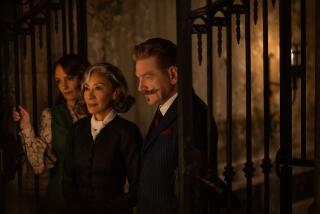Review: ‘The Bicycle Thief’
- Share via
If film means anything to you, you’ve at least heard of the Italian neorealist classic “The Bicycle Thief,” in its time, as the Village Voice’s J. Hoberman has written, “surely the most universally praised movie produced anywhere on planet Earth.”
But even if you watched it way back in the day, it’s likely been decades since you’ve seen it. Directed by Vittorio De Sica and first released in the U.S. in 1949, “Bicycle Thief” has become one of those venerable masterpieces that people pay lip service to but never revisit out of fear that it has somehow become dated. And that would be a terrible mistake.
In fact, to see “Bicycle Thief” again in a new 35 mm print struck for its 60th anniversary and screening starting today at the Music Hall in Beverly Hills is to experience what feels like a miracle. For this killer of a film not only hasn’t lost a step since it won a special Academy Award and helped pave the way for the foreign language Oscar category, it’s even more involving now than it was then, a singular emotional juggernaut that has the kind of unrestrained power contemporary films can only dream about.
Told in brief summation, “The Bicycle Thief,” written by Cesare Zavattini and several collaborators based on a novel by Luigi Bartolini, has a narrative premise that sounds so slight it seems highly unlikely to be made into a film at all, let alone one that would captivate so many for so long.
After being unemployed for two years, Antonio Ricci (Lamberto Maggiorani) finally gets offered a job putting up movie posters and the like on the walls of post-war Rome, but only if he has a bicycle. Getting his hands on one is difficult, but he succeeds, and his wife Maria (Lianella Carell) and his young son, Bruno (Enzo Staiola), are delighted. But on his first day at work, Antonio’s bicycle is stolen, and he spends the rest of the film trying to get it back.
Classic tragedy
That this slender tale ends up having the emotional resonance of classic tragedy may sound preposterous, but that is what happens. “The Bicycle Thief” places us right there, allows us to live what turns out to be a shattering experience with these people, lets us feel for them in a deep and profound way that is almost beyond describing.
Making all the difference in this were the tenets of neorealism, a movement that took hold, partly out of ideological conviction and partly out of the necessity of a post-war lack of resources, in Italy in the late 1940s and early 1950s.
Neorealist films -- others include “Open City,” “Shoeshine,” “Paisan” and “Umberto D” -- were shot on real locations with available light, used nonprofessional actors and often had socially conscious themes. This may sound like business as usual to young directors trying to get into Sundance, but at that time telling movie stories so far outside the conventions of Hollywood was revolutionary.
But just because “Bicycle Thief” cared about reality doesn’t mean it was slipshod or improvised. The film is beautifully photographed by Carlo Montuori, features a subtle Alessandro Cicognini score and in De Sica had a director who put every scene together for maximum effectiveness. He painstakingly choreographed crowds and even hired 40 vendors for a scene where Antonio, his son and his friends look for the stolen bike in an open air market.
Key to casting
An equal amount of care went into selecting key cast members, especially the father-son team. Maggiorani, a factory worker who was selected when he brought his son to audition, has a handsome, almost noble face that soon becomes a mask of worry and tragedy. And 10-year-old Staiola, whose parents owned a vegetable cart in Rome, simply has one of the most unforgettable and expressive childhood faces in the history of cinema.
Because De Sica’s previous film, “Shoeshine,” had had some success, he was able to pitch this story to “Gone With the Wind” producer David O. Selznick, who apparently suggested Cary Grant for the lead. De Sica demurred. “I needed the spontaneity of untrained talent,” he said at the time of the film’s release. “There is a freshness in their response to simple realities that was right and valuable to these pictures.”
Seen from the perspective of today, it is the spareness and restraint of the film in general and the performances in particular that make “The Bicycle Thief” such a powerful experience. That, and something more.
For this film manages to appeal to the better angels of our nature in a way that only deepens as we grow older along with the film.
The passage of time has only intensified the resonance of something De Sica said 60 years ago: “We are so tired, we have lost any feeling of responsibility toward anyone but ourselves and, when we cut ourselves off from our brother, we prepare our own destruction.” See “The Bicycle Thief” and delay the apocalypse, if only for an 89-minute span.
More to Read
Only good movies
Get the Indie Focus newsletter, Mark Olsen's weekly guide to the world of cinema.
You may occasionally receive promotional content from the Los Angeles Times.











